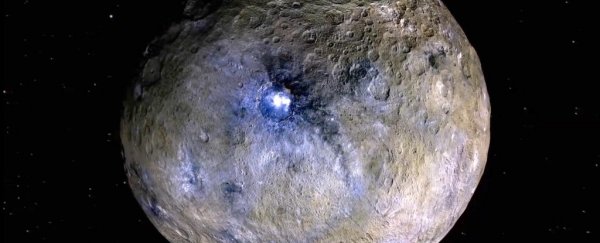The dwarf planet Ceres was once assumed to be a fairly primitive chunk of rock. But just a few years ago, NASA's space probe Dawn revealed that there's more to this asteroid belt body than meets the eye.
Now, we're starting to find out just how much more. Ceres sits in the asteroid belt between Mars and Jupiter, and is simultaneously the largest asteroid in the Solar System, and the only dwarf planet closer than Neptune.
And, according to a new analysis of Dawn data, Ceres is an ocean world. It has a subsurface body of briny water that could be spanning the entire dwarf planet.
The discovery escalates the importance of sending a new mission to study Ceres in greater detail in order to gauge its potential habitability - and maybe even search for signs of extraterrestrial life.
It all started in early 2015, before Dawn even arrived for its three-year stint orbiting Ceres. The probe recorded strange, anomalously bright spots called faculae in the dwarf planet's Occator crater, a 20-million-year-old impact crater.
Scientists later established that these shiny patches were created by sodium carbonate - a kind of salt.
Here on Earth, sodium carbonate is found around hydrothermal vents, deep in the ocean, where heat seeps into the water from cracks in the seafloor. Although far from the light of the Sun, which enables the photosynthesis on which most of Earth's life relies, these vents are teeming with life, a food chain relying on chemosynthetic bacteria that harness chemical reactions, rather than sunlight, to generate energy.
But the source of Ceres's sodium carbonate remained a subject for debate. Did it come from subsurface ice that melted in the heat of the Occator impact, only to later refreeze? Or was there a deep brine layer at the time of the impact that seeped through to the surface, suggesting the interior of Ceres was hotter than we thought? And could that brine still be there?
Well, according to a series of papers published today in Nature journals, the answer to the last two questions seems to be an emphatic yes, with several convincing lines of evidence all pointing in the same direction.
The data analysed were collected in the final phase of Dawn's mission. Running out of fuel, the spacecraft swooped in to an altitude of just below 35 kilometres (22 miles), collecting data in spectacular resolution: 10 times higher than the prime mission, with a particular focus on the Occator crater.
At this resolution, Dawn could record gravity variations in the crater on the scale of the geological units in and around it. These gravity variations, combined with thermal modelling, suggest density variations consistent with a deep reservoir of brine below the crater.
This reservoir could have been mobilised by the heat and fracturing that resulted from the impact, spurting up and out to create the salt deposits we see today.
"Moreover," the researchers wrote, "we find that pre-existing tectonic cracks may provide pathways for deep brines to migrate within the crust, extending the regions affected by impacts and creating compositional heterogeneity."
A second study using the gravity data, in combination with shape data, found that Ceres's crust is quite porous, but that porosity decreases with depth, possibly as the rock mixes with salt.
Although the crater is around 20 million years old, there's evidence to suggest the salts on top of it are much, much younger. High-resolution images indicate that the ice volcanoes of Ceres could have been active as recently as 2 million years ago, millennia after the heat from the impact would have dissipated, indicating a deep source of brine.
And this is supported by a surprise discovery - the presence of a rare mineral, hydrohalite. Spectrometry revealed this hydrated form of sodium chloride at the very top of the dome of the Cerealia Facula, the brightest spot in the Occator crater.
The funny thing about this mineral is that it requires moisture, and dehydrates quite rapidly - within, according to the team's calculations, tens to hundreds of years. This suggests that it must have gurgled up from inside Ceres shockingly recently.
But the deposition of different salts on the surface has another implication - they could have come from different sources.
In the first instance, the heat of impact melted a bunch of ice, which flowed out and altered the terrain inside the crater, depositing salts in the Cerealia and Pasola Faculae. Then, more slowly, brine from a deeper reservoir made its way to the surface, contributing to Cerealia and Pasola, and wholly creating the thinner Vinalia Faculae on the crater floor.
It all adds up to a pretty dizzying picture. Ceres is a lot stranger and more complex than we knew, joining the moons Europa, Ganymede, Callisto, Enceladus, Titan and Mimas, and dwarf planet Pluto, as potential ocean worlds.
But how Ceres formed and where it came from are both mysteries. Now, we can add to that the mystery of how it retains enough heat to support a subsurface reservoir or ocean.
A mission to Ceres was recently selected by NASA to be developed as a concept study, due for publishing in the 2023 Planetary Science Decadal Survey. The other candidates have their charms, but sending a rover and maybe even a sample return mission to Ceres is starting to look more and more enticing.
The papers have been published in Nature Astronomy, Nature Geoscience, and Nature Communications.
